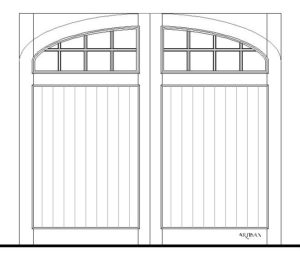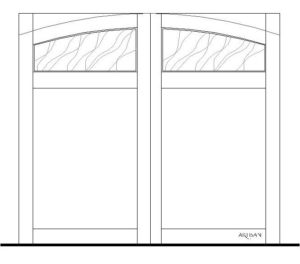How To Measure Your Garage Door
Every Artisan door is custom-built to meet your exact requirements, including the measurements of your garage opening. If you’ve never done this before, it can be hard to know where to start. Our guide below highlights how to measure garage door torsion springs, bottom seals, arches, and clipped corners.
We’ll ask for four different measurements to ensure a good fit for your customized overhead garage door. Whether you’re measuring for a single or double door, you’ll want to take these measurements from the inside of your garage.
- Door Opening. This measurement will be the height and width of the finished, existing garage door opening. You should measure the height from the floor to the top inside the door jamb, and the width is measured between the left and right jambs.
- Sideroom. The sideroom is the area between your overhead door opening and the nearest wall or obstruction. This space will be where the vertical tracks are installed. You should take left and right side room measurements that account for both the track and space we’ll need to operate installation tools.
- Headroom. We’ll ask for a headroom measurement, which is the space from the top of the door opening to the lowest overhead obstruction, like your ceiling or exposed roof rafters. This area will hold the vertical track curves and the horizontal track that holds the door section when your garage door is open.
- Backroom. The final measurement we’ll need to ensure a great fit is the backroom. This is the clear area at the ceiling or rafters where your horizontal door track will be hung and where the automatic opener is placed.
Our Benchmark series is a popular style that comes with the option for an arched or ellipse top door. To make sure our customizations are correct, we’ll need some measurements from you.
- Door width. By knowing the door width, you’ll also already know how to measure your garage door bottom seal. Make sure to measure jamb to jamb at the bottom of your door opening.
- Door Opening at Peak Height. Unique to a curved arch, there will be two measurements for the height of your door opening. The first is to the peak of the curve or arch.
- Door Opening at Spring Line of Arch. The second height measurement will be from the bottom of your door to the lowest point of the arch. This is also known as the spring line of the arch.
We’ll need both of these measurements because a majority of arched or ellipse door tops are simulated, meaning there’s a hidden square top behind the opening of your desired arch design.
Download Our Arch & Ellipse Measuring Sheet
Clipped Corner Door
Similar to arch and ellipse top doors, clipped corners need a few specific measurements to make sure our team creates the perfect fit. Our downloadable guide will help make sure you provide the correct measurements.
We’ll need the door width, the full door opening height, and the height of the door from the bottom to the lowest point of the clipped corner. In addition to these, we’ll also need the width between the clipped corners.
We’ll need three opening measurements for your true swing, slider, or pedestrian (entry) door. If your new door is replacing an existing one, you’ll just need to provide the finished and masonry opening measurements.
- Rough Opening. Typically used in new construction, the rough opening is the space created by the rough wood framing. This includes king studs, jack/trimmer studs, header, and subfloor sheathing.
- Finished Opening. This opening is the space created by the finish trim that’s installed in the rough opening. The casing has been installed, and the jamb should be ready for the door hinges to be screwed into place.
- Masonry Opening. A masonry opening is the physical masonry that the door jamb is attached to. This opening is unique to you, and more complex than the other measurements. We recommend contacting our team, or your local dealer to ensure you’re providing us with the right numbers.
The last piece is how to measure garage door torsion springs. To know what size torsion springs you’ll need, you’ll need to know the height of your garage door and the circumference of the cable drum. Once you have these two measurements, divide the height by the circumference.
Templates are especially useful for arch and ellipse top doors. To make a template, mount a non-stretchable material across the inside of your open garage door. Then, trace the exact outline of the opening onto the material from outside the door.
Our team recommends using white house wrap, building felt, roofing paper, or brown kraft paper. The material must be a single piece that’s long enough to cover the entire door opening without being pieced together.
If you still have questions as you begin measuring your garage door, our representatives are available to walk you through the template and measuring process.
Get Your Questions Answered
Want to learn more about purchasing an Artisan garage door, or have additional questions on measuring your existing door opening? We’ll connect you with your local dealer who can guide you through the design, ordering, or measuring process.

